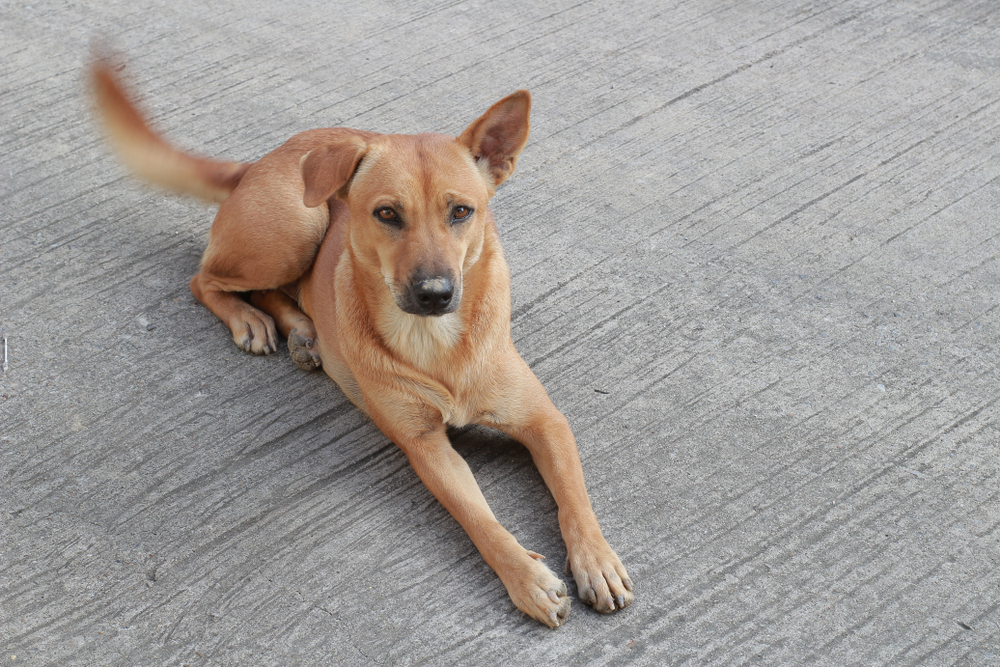There are few things more lovely than coming home to your doggo. They’re bounding left and right, and jumping up to get your attention. They’re also wagging their tail furiously – it’s pretty obvious they’re just as excited to see you as you are to see them. But about that tail wagging… sure, dogs flick their tails to and fro when they’re in a happy mood, but are there other reasons they do it? Just why do dogs wag their tails?
It turns out tail wagging can indicate a whole spectrum of canine emotions. If you’re keen to learn more about waggly tails – and decipher your doggo’s mood – read on!
Why do dogs wag their tails?
As we well know by now, dogs are unable to simply tell us how they’re feeling. Instead, they use sounds like barks, whines, and growls, as well as body language, to communicate and convey their emotions.
By gauging your dog’s body language, you can often tell what kind of mood they’re in. If the front of their body is low to the ground and their butt is high in the air, they might be telling you they want to play. If their entire body is low to the ground, though, and the hair is standing up on their back, they’re likely feeling quite the opposite: scared and possibly aggressive.
A dog’s tail is no different. It’s simply a way for pooches to show their feelings to other dogs or humans. And while it’s commonly believed that a wagging tail signals excitement or a good mood, that’s not always the case. Tail-wagging is merely a sign that a dog is in an emotionally aroused state. Dogs wag their tails to indicate all kinds of emotions, from feeling calm or happy, to experiencing stress.
Do dogs wag their tails on purpose?
So, when a dog wags their tail, do they control it or is it just an instinctive reaction to something? Well, tail-wagging is actually a bit of both.
A dog can technically control the movement of their tail, however, tail-wagging is more subconscious. In short, it’s both an intuitive and regulated response. If you’re as confused by that as we are, think of it like human laughter. If someone tells a hilarious joke, your first instinct may be to burst out laughing. But, you can also control this reaction if you want to.
And when do dogs develop this behaviour? Usually, when they’re very young. While it’s inherently within them, puppies typically don’t wag their tails until they’re at least a few weeks old. Experts reckon this supports the idea that tail-wagging is learned (from their mother) as much as it is a natural behaviour.
How to decipher a dog’s mood based on their tail
Curious as to how you can decode your dog’s tail movements to figure out their mood? The three key factors here are speed, tail height, and direction.
Speed
If your dog’s tail is wagging very quickly, it’s usually a sign they’re excited. The faster that tail is wagging, the more excited they’re feeling. However, a rapidly wagging tail isn’t always that simple.
Their excitement could be a good thing (perhaps their favourite local Dog Walker has just arrived at the door!) or it could be a negative thing. Some dogs get excited when they’re nervous or anxious, or even when they’re feeling aggressive. If your doggo’s tail is pointing straight up and wagging briskly, it could be a sign of hostility.
On the other end of the spectrum is a slowly wagging tail. This can indicate that a dog is unsure about something and hasn’t worked out how to react yet. You may notice this when your doggo is meeting someone for the first time.
Tail height
The height of your pupper’s tail is another great way to tell how they’re feeling.
A calm and relaxed dog will likely hold their tail in a neutral position, about the height of their body. This may be accompanied by gentle wagging.
A lowered tail, or a tail between the legs, indicates that your dog is stressed or nervous. They may also place their tail right under their body, in which case they’re likely scared of something.
If your dog raises their tail slightly above their body, they may be curious or on high alert.
And if it’s bolt upright or arched over their back, and accompanied by that rapid wagging we mentioned earlier, this could indicate aggression.
Direction
The direction of a wagging tail is where things get really interesting. A study from 2007 found that left and right movements are a strong sign of a dog’s emotional state. The experts involved in the study worked out that if a dog’s tail wags to the right, it’s a sign they’re experiencing positive emotions. If it’s wagging to the left, it’s a sign of negative emotions.
This is all to do with the different sides of the brain. The left side of the brain controls the right side of the body, and is associated with positive emotions. The right side of the brain controls the left side of the body, and is associated with negative emotions.
The same study discovered that dogs tend to wag their tail to the right when they encounter someone familiar. The experts suggest this could mean the dog is happy to get closer to that person. But if a dog comes across someone they’re not sure of or don’t want to approach, they’re likely to wag their tail to the left.
And because tail-wagging is such a crucial part of a dog’s communication toolkit, other dogs tend to respond to left and right wagging. A 2013 study found that if dogs wagged their tail to the right, other pooches felt calm and relaxed. If they wagged to the left, other dogs felt more apprehensive and stressed.
The final word on “Why do dogs wag their tails?”
You can usually use these signs to gauge your dog’s mood, but know that there are variances among dogs.
Different breeds have different tails, so it’s not always easy to use a wagging tail as an indication of mood. A curly-tailed Pug, for example, technically always has their tail arched over their back. On the other hand, a long-tailed Irish Wolfhound may keep their tail low at most times. Golden Retrievers often have tails that sway from side to side in various situations. Some dogs barely have tails at all.
So while tail-wagging is certainly important, look out for other signals when figuring out your dog’s feelings. Cues like verbalisation and body position may offer a more comprehensive deep-dive into your doggo’s mind!


